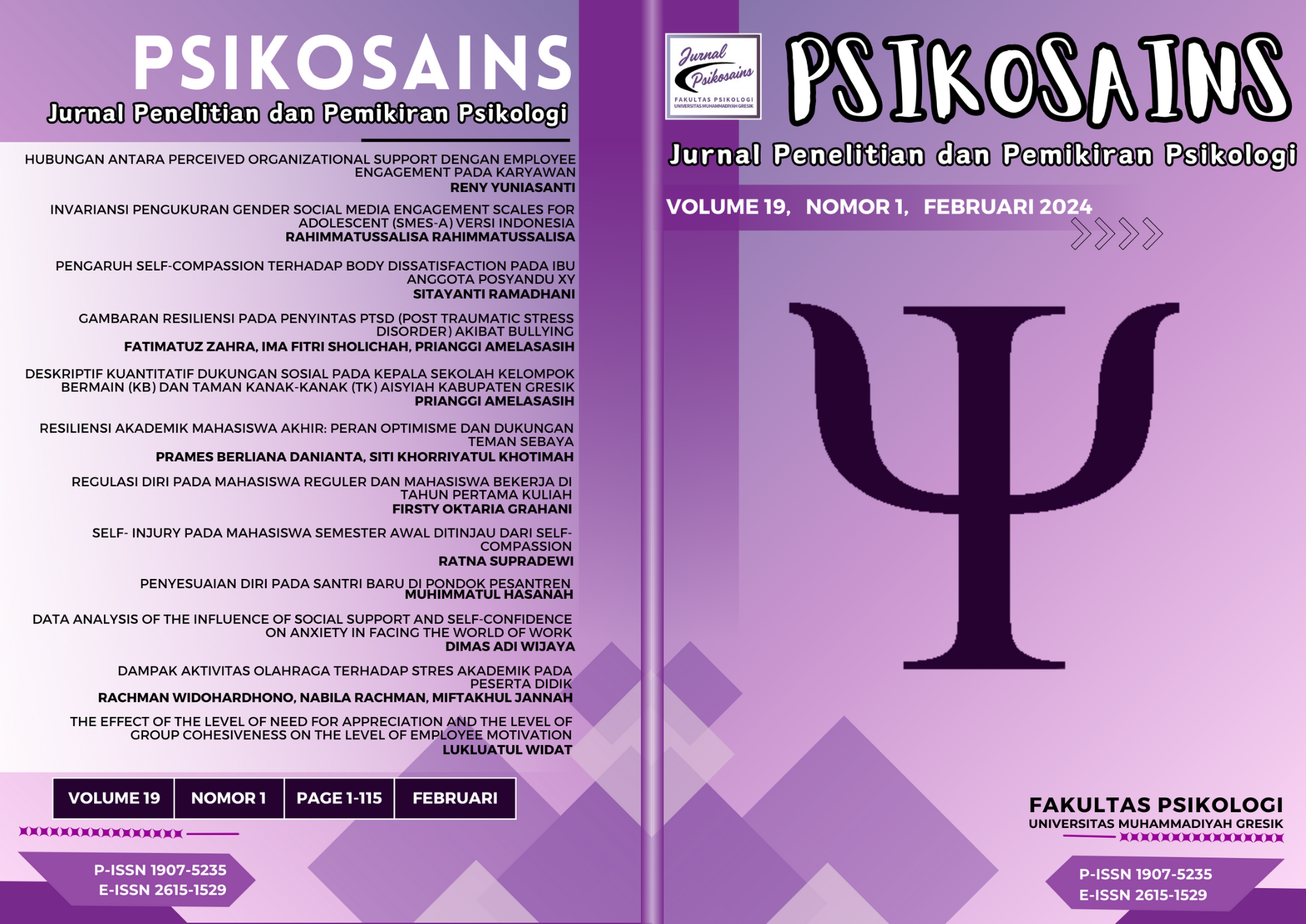PENGARUH SELF-COMPASSION TERHADAP BODY DISSATISFACTION PADA IBU ANGGOTA POSYANDU XY
DOI:
https://doi.org/10.30587/psikosains.v19i1.6758Abstract
Background: Body dissatisfaction is caused by individuals comparing their
perceived body image with other people, overestimating body shape and
drastic changes in their body. Objective: This research was conducted to test
whether there was an influence between self-compassion on body
dissatisfaction in XY integrated healthcare center mothers with a total of 46
subjects. Based on the analysis results obtained from the simple linear
regression test, the sig value was 0.044. Method: This research is a type of
quantitative research with simple regression analysis which measures the
magnitude of the influence between the dependent variable and the
independent variable .the subjects in this study were 46 mothes were members
of posyandu XY. Result: This means that the significant value is 0.05, so it can
be seen that self-compassion (x) influences body dissatisfaction
(y),Conclusion: It was concluded that the results of hypothesis testing
obtained a simple linear regression value of self-compassion on body
dissatisfaction with a sig value. (2-tailed) of 0.044. Compared to the
significance level of 0.05 (5%), this sig (2-tailed) value is 0.05 (5%) smaller.
This means that there is an influence of the self-compassion variable (X) on
body dissatisfaction (Y). This research shows a figure of 0.089, which means
the self-compassion variable contributes 8.9% to the body dissatisfaction
variable.
References
https://doi.org/10.1016/S1740-1445(03)00011-1
Germer, C. K., & Neff, K. D. (2013). Self-compassion in clinical practice. Journal of Clinical
Psychology, 69(8), 856–867. https://doi.org/10.1002/jclp.22021
Grogan, S. (2006). Body image and health: Contemporary perspectives. Journal of Health
Psychology, 11(4), 523–530. https://doi.org/10.1177/1359105306065013
Hui, M., & Brown, J. (2013). Factors that Influence Body Dissatisfaction: Comparisons across
Culture and Gender. Journal of Human Behavior in the Social Environment, 23(3), 312–329.
https://doi.org/10.1080/10911359.2013.763710
Intan, C., Hati, P., Soetjiningsih, C. H., Kristen, U., & Wacana, S. (2022). Hubungan Self Compassion
Dengan Body Dissatisfaction Pada Dewasa Awal Pengguna Instagram.
https://doi.org/10.24036/rapun.v13i2
Lupton, D., & Fenwick, J. (2001). “They’ve forgotten that I’m the mum”: Constructing and practising
motherhood in special care nurseries. Social Science and Medicine, 53(8), 1011–1021.
https://doi.org/10.1016/S0277-9536(00)00396-8
Marizka, D. S., Maslihah, S., & Wulandari, A. (2019). Bagaimana Self-Compassion Memoderasi
Pengaruh Media Sosial Terhadap Ketidakpuasan Tubuh? Jurnal Psikologi Insight, 3(2), 56–69.
https://doi.org/10.17509/insight.v3i2.22346
Marshall, C., Lengyel, C., & Utioh, A. (2012). Body dissatisfaction: Among middle-aged and older
women. Canadian Journal of Dietetic Practice and Research, 73(2), 241–247.
https://doi.org/10.3148/73.2.2012.e241
Maxwell, M. A., & Cole, D. A. (2012). Development and initial validation of the adolescent responses
to body dissatisfaction measure. Psychological Assessment, 24(3), 721–737.
https://doi.org/10.1037/a0026785
Mercer, R. T., & Ferketich, S. L. (1995). Experienced and inexperienced mothers’ maternal
competence during infancy. Research in Nursing & Health, 18(4), 333–343.
https://doi.org/10.1002/nur.4770180407
Neff, K. D. (2011). Self-compassion, self-esteem, and well-being. Social and Personality Psychology
Compass, 5(1), 1–12. https://doi.org/10.1111/j.1751-9004.2010.00330.x
NEFF, K. D. (2003). The Development and Validation of a Scale to Measure Self-Compassion. Self
and Identity, 2(3), 223–250. https://doi.org/10.1080/15298860309027
Neff, K., & Germer, C. (2018). The Mindful Self-Compassion Workbook: a proven way to accept
yourself, build inner strength, and thrive. 1–207.
http://library1.nida.ac.th/termpaper6/sd/2554/19755.pdf
Puspitasari, A. I., & Ambarini, T. K. (2017). Hubungan Social Comparison dan Body Dissatisfaction
Pada Remaja Perempuan. Jurnal Psikologi Klinis Dan Kesehatan Mental, 6, 59–66.
Putri, R. A., Fitriyanti, E., & Burhanudin, B. (2021). Layanan informasi berbasis self-compassion
untuk mereduksi body dissatisfaction pada siswa perempuan. Orien: Cakrawala Ilmiah
Mahasiswa, 1(1), 59–66. https://doi.org/10.30998/ocim.v1i1.4573
Rosen, J. C., & Reiter, J. (1996). Development of the body dysmorphic disorder examination.
Behaviour Research and Therapy, 34(9), 755–766. https://doi.org/10.1016/0005-
7967(96)00024-1
Regina T.M. Napitupulu (2016). Hubungan Antara Body Dissatisfaction dengan Psychological Well-
Being pada Emarging Adulthood. Skripsi tidak diterbitkan. Universitas Surabaya
Sugianto, D., Suwartono, C., & Sutanto, S. H. (2020). Reliabilitas dan validitas Self-Compassion
Scale versi Bahasa Indonesia. Jurnal Psikologi Ulayat, 7(2), 177–191.
https://doi.org/10.24854/jpu107
Suprapto, M. H., & Aditomo, A. (2007). Aku dan dia, cantik mana? perbandingan sosial, body
dissatisfaction dan objektivikasi diri. Indonesian Psychological Journal, 22(2), 186–191.
https://repository.ubaya.ac.id/25251/
Wati, D. K., & Sumarmi, S. (2017). Citra Tubuh Pada Remaja Perempuan Gemuk Dan Tidak
Gemuk : Studi Cross Sectional Body Image Among Overweight and Non overweight Adolescent
Girls : A Cross Sectional Study. 044, 398–405. https://doi.org/10.20473/amnt.v1.i4.2017.398-
405



